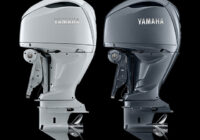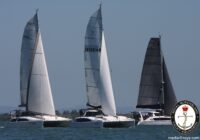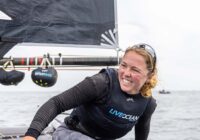The shutters opened at the INEOS Britannia base just after 5am on Saturday, and out into the moonlight under floodlight came the boat that all British fans hope will have the best chance of winning the Louis Vuitton 37th America’s Cup in 173 years. Codenamed RB3 for the past two-and-a-half years, the latest AC75 to be revealed is outlandishly stunning with an all-business paint job that accentuates the curvature of the hull form and tricks the eye. Detailing aplenty, it’s a subtly different approach from what we’ve seen so far and represents the very best of design and build.
The most obvious talking point is the hull form. What the British have gone for is a step-on from their prototype boat ‘T6’ with a voluminous, integrated bustle in the bow with a small chine leading back along the keel-line to a razor-sharp edged lower bustle that stops a few feet from the stern.
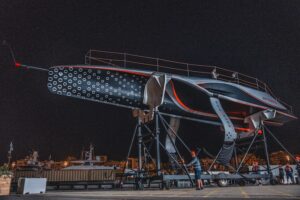
© Cameron Gregory
The flaring at the bow is somewhere mid-way between the Kiwis and Italians. Ending the bustle before the transom leaves presumably the majority of the rudder mechanics above deck on the gantry so there’s an aero trade-off with a considerable, but beautifully sculpted, stern gantry that screams Formula 1 design. The almost dead flat stern run off is an area unlikely to be touching water in flight – that’s the thinking at least – and is similar to what we have seen elsewhere.
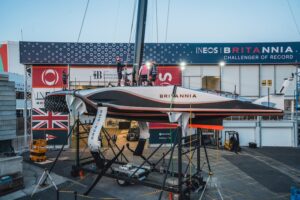
© Cameron Gregory
The area of much interest in this Cup cycle is the aero moulding of the deck and here INEOS Britannia looked to have aced it. Similar in form to both Emirates Team New Zealand and Luna Rossa Prada Pirelli but with perhaps slightly more ‘tunnel’, the deck run off aft is highly aero optimised. The cyclor pods end with a gradual pinch that flows all the way to the transom and the four pods either side look to again be a big nod to aero – we will see more when RB3 is launched. Up on the bow there is considerable moulding that appears drop-nosed in form, undoubtedly the result of endless hours in the simulations to create the perfect flow into the jibs.
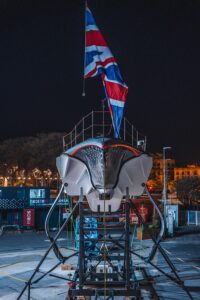
© Cameron Gregory
Down below the foils were shrouded as today was merely a roll-out and mast step exercise before the team get sailing but the trend for back-slung foils, as far back as possible from the bulb and arm is seen. The British look to be using Version 1 of their foil allowance and eschewing the option of putting legacy foils on for the commissioning phase as we’ve seen with the Kiwis and Italians.
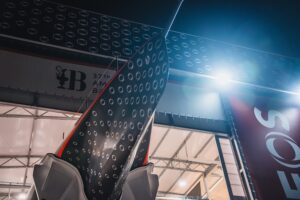
© Cameron Gregory
Speaking about the reveal, INEOS Britannia Team Principal and Skipper Sir Ben Ainslie said: “This is a big day for the team. We have been keeping RB3 under wraps for such a long time that it’s almost surreal to see her out of the shed and in public view here in Barcelona. Thousands of hours of work have gone into this boat and so it’s great to finally reveal her to the world. Things are really stepping up in the campaign now, and we are looking forward to launching RB3 and getting out on the water very soon.”
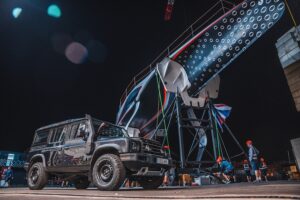
© Cameron Gregory
The fusion of outstanding naval architect Martin Fischer and the Mercedes Applied Science team in Brackley, Northamptonshire has produced something very special here and with an experienced team of America’s Cup sailors, hopes are high and getting higher that at long last Britain has the design that is capable of going deep into the competition with a shot at winning the Auld Mug.
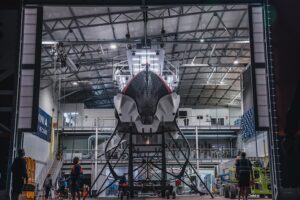
© Cameron Gregory
As ever, what is going on downstairs with the sail controls, power delivery, electronics and mechatronics could be the difference between success and failure – and it’s there where INEOS Britannia could well surprise. The British programme to the Louis Vuitton 37thAmerica’s Cup took a giant leap forward today and the coming weeks will see the campaign go into over-drive with long hours on the water as they work the boat up to race-ready. Could this be the boat that trumps them all – time will tell. (Magnus Wheatley)
On-Water Recon Report – INEOS Britannia: Challenger of Record, INEOS Britannia, rolled out their new AC75, RB3, at 05:15. The yacht, without its rudder, was rotated around the forecourt on its motorized cradle to face the south wind, ahead of a long day of mast levelling and instrument calibrating.
The plumb bow starts sharp and maintains a steep deadrise towards the forward cradle, flaring out to a flat bottom from foil arm pivots. A noticeable bustle starts off in a bulbous form, about 1m from the bow, continuing to the transom, tapering off towards the stern. A thin skeg runs horizontal down the bustle, enlarging as the hull bottom rises to meet the deck, ending a few meters before the rudder housing.
The sheerline raises from the bow and the flat deck continues to the sidepods. The sidepods start behind the foil cant arms, containing 4 crew pods in line on each side, separated with a trench deck approximately one foot deep. The trench runs flat down the middle to the transom, with a gentle flare to meet the sidepods. The sidepods taper towards to the thin transom, maintaining flat topsides and the sheerline in a straight line down. The topsides meet the flat bottom at a 90 degree angle.
Only the aft half of the deck was visible from outside the base. The mainsheet system lie in its cradle on the deck, connected to hoses. A sheave can be seen connected to the end of the mainsheet actuator, with two mainsail skin clew actuators on either side (not connected to each other). The traveller sits in a cut out below deck. The rudder stock fairing takes a concave outline in body plan view, with openings at the tail’s edges.
The foils were shrouded below the one design foil cant arms. The leading edge of the foil recedes slightly from the one design section and continues to the front of the torpedo bulb. The high aspect wings connect aft of the bulb, slightly anhedral, with pronounced wingtips. The starboard wingtips had boxes over them, perhaps with camera bulbs on them as on ARBR Boat One. Towards the end of the day, the shrouding fell slightly, revealing seemingly unfinished paint work.
The rigging was rolled out with Harken cunningham actuators now fitted. The mast was stepped at 06:50, with laser levels on stilts and measuring tapes dropped from the hull, to find the orientation of the boat. The team worked on setting the rig following a strict procedure. The rig was lowered at 08:30, with works carried out and new strops fitted. The rig was stepped again at 12:20 and work continued above and below deck until the late evening. The mast was still up by 20:00.
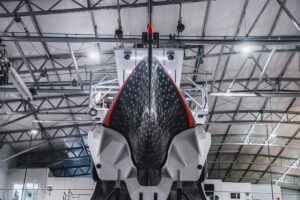
© Cameron Gregory







